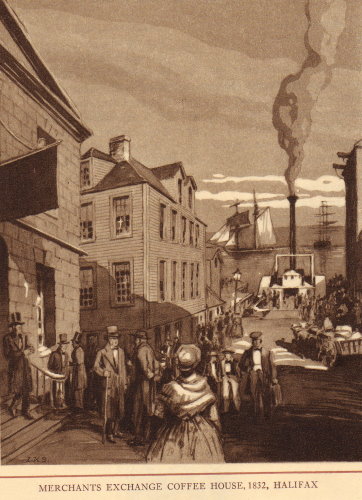
Book #3:
The Road To Being Canada (1815-1867)
Chapter 17, Banks

The origin of the function of a bank is traceable back to the early part of the 18th century when men in partnership extended their business over wide geographical areas and the collection of what was owned to the company may be more peculiar to one area than to another; and, the funds collected were held by the collecting partner, or "banked," for the use of the company at another place or at another point in time. The prime essential in setting up a bank, in the sense that a bank is a stock of money, is that the people setting up a bank "are men whose debts (or promises to pay) are widely accepted by others as though they were legal money: it is part of their business to create means of payment other than hard cash. They must be (or thought to be) men of substance and integrity; and some of the bankers of this period owed little to anything but their own resources and character."1
Merchants at Halifax, many of whom were involved in international trade such as Collins and Cunard who most certainly had resources and character, were keen on setting up a local bank so as to accommodate the settlement of international accounts. It was simply courting a loss to be carrying gold or silver on cargo ships so to settle accounts created by an international trade; better to be carrying a Letter of Credit issued by a recognizable bank. So it was that a leading group of Halifax merchants established Nova Scotia's first bank, the Halifax Banking Company. It opened September 3rd, 1825.2 It advertised itself as a bank of issue and discount. It was a private company which issued notes that would be exchanged for gold or silver. The principals behind the bank had sought a charter from the Legislative Assembly but were denied. As it turned out, they did not need the government's OK or assistance. They succeeded on the strength of their reputations and available capital. The initial capital of the bank was £50,000 divided into ten shares. Two shares went to Henry H. Cogswell who became its president. The remaining shares were taken up by Enos Collins (the bank was locally known as Collins' Bank), Samuel Cunard, Joseph Allison, James Tobin, William Pryor, Martin Gay Black and John Clark.3 Though this first bank accepted deposits, it paid little attention to that branch of banking, and concentrated on foreign exchange and the profits to be made at that end.4
It is necessary only to mention the other banks in Nova Scotia which sprang up shortly after the success of Halifax Banking Company: The Union Bank of Halifax, The Mercantile Banking Corporation, The Merchants Bank of Halifax, The Pictou Bank, The Bank of Yarmouth, The Exchange Bank of Yarmouth, The Bank of Acadia at Liverpool and The Bank of Liverpool.5 Many of the Canadian banks of today can trace their beginnings to these banks that were setup in Nova Scotia during the first half of the 19th century. Others need to be mentioned. On December 31st, 1831, the Bank of Nova Scotia was first organized at the Merchants' Exchange Coffee House at Halifax. And on September 20th, 1837, the Bank of British North America began operations at Halifax. It was founded in 1835 in London, England, with offices eventually in Toronto, Montreal, Quebec City, Saint John and St. John's. It also operated agencies in New York City and San Francisco. The Bank of British North America merged with the Bank of Montreal in 1918. In 1864, the Merchants' Bank of Halifax opened; it in time it became the Royal Bank of Canada.